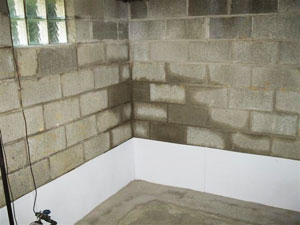Hi,
| |
I have a section of my basement that was previously finished with 2x3 studs placed about 1" from the concrete wall and covered with 70's paneling. Upon removing a section of panel for access for an electrician, we discovered a lot of efflorescence on the walls with a few small areas where the outer 1/4-1/2" of the outer surface of the concrete was crumbling and powdery. After cleaning with citric acid, patching the bad areas with Drylok fast plug, sealing with Drylok masonry treatment, and 2 coats of Drylok waterproofing we are ready to start rehanging the paneling and eventually painting it. We have never had any water in the basement, only dampness, especially since 2003 so we run a dehumidifier in the summer. (50yo house).
I was wondering about insulation and if we need it at all. There was a plastic sheet put up on the studs before the paneling was originally installed. I don't want to use fiberglass batts do to the fact that loose fiberglass bothers me. (I have friends that insulated the floor joists and the fiberglass rains down on you). Also I have read that fiberglass against the wall can get moldy. The room is sometimes heated with a wood stove. Would some type of polyisocyanurate foam board work to stop possible condensation of the cold concrete walls? I could put it up behind the studs directly on the wall.
Any suggestions would be appreciated.
Thanks,
-Mike
 Hi Mike,
Hi Mike,
Any type of foam board would be the best material to use. You can use paneling glue to adhere it to the concrete walls. Also remember to tape at all the seams where the individual foam boards meet.
-Simply Additions
Would I need to put the plastic back up under the paneling?
Also the contractor that did the siding/window remodel a few years ago recommended insulating
the sill area at the top of the foundation with fiberglass enclosed in bags for that purpose but I have not been able to find it at building supply house, do you know where I can find this sill insulation?
Thanks,
-Mike
Hi Mike,
I would not put up plastic between the concrete wall and the back of the foam board. As long as you create a nice tight thermal barrier between the concrete and the heated space (the room) you will not have condensation. Plastic doesn't allow the foam board to breath, you want to keep the air in the room conditioned, but the plastic may actually prevent any moisture in the concrete wall from getting into the conditioned space. You want a little moisture to get into the basement because it is natural. If you completely encapsulate the room in plastic; moisture will not pass through and water droplets will surely collect on the outside of the plastic.(facing the concrete) You can end up with a smelly basement and even mold
I am not sure of any sill insulation wrapped in plastic, but Lowes has batt insulation that comes pre-wrapped in plastic. Maybe thats what your contractor was talking about.
-Simply Additions
Hi,
when I said do I need to put the plastic back up, I meant that it would be stapled to the studs, with the foam board glued to the wall behind the studs, not the plastic behind the foam board. The plastic was originally directly behind the paneling and thats where I'll put it back if I need it at all. I think the foam board actually comes with foil on it and I saw where they recommend putting up .5" sheet rock as a thermal barrier but that is not an option for me since I will reuse the paneling and paint it. (I need to get the room out of the 70's!)
Thanks,
-Mike
|
|
Last year, I have use fiberglass for basement insulation. After that I had faced the mold problem. So I do not use fiberglass. Recently, I have purchased dehumidifier. Manufacturer advises me for arranging proper sunlight. Sunlight always reduces humidity in the air and thus helps to make dry the basement.
-Elfriedamiller
Just a friendly reminder that you can use our Automated Contractor Locating Service to find the right Basement Remodeling and Basement Waterproofing professionals in your area by filling out the simple form below.

